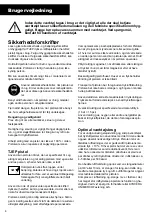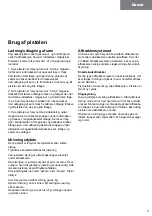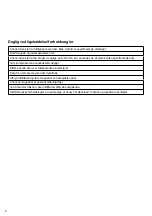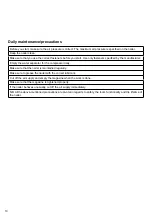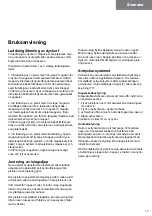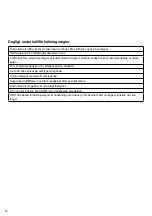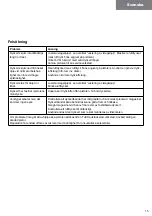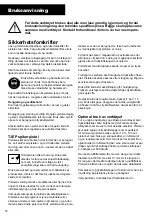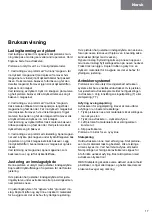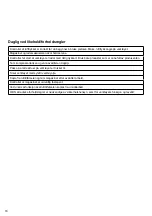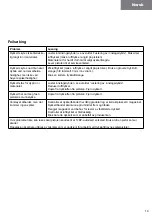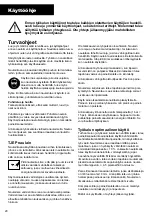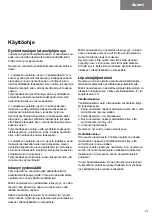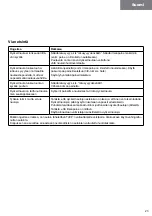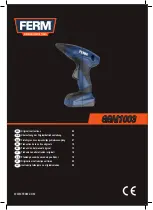
8
User guide
Before using this tool, it is important that all users read the manual and the
technical specifications carefully. These documents should be kept with the
tool. For questions, please contact the vendor of the tool.
Safety instructions
Read and learn all safety and operating instructions
thoroughly before using the TJEP finish/brad nailer
(hereafter: nailer). Follow all safety regulations carefully.
By failing to follow the safety regulations, you may harm
yourself or others.
Keep the nailer away from children. The nailer is dan
-
gerous in the hands of an untrained person.
The tool may only be used for nailing wood or materials
with similar hardness.
Always use safety glasses and hearing
protection when the nailer is in use. Other
people in the work area should use
appropriate personal protective equipment
such as eye and ear protection.
Always remove the air supply from the nailer, when the
nailer is not in use, before maintenance, cleaning or if a
nail has jammed.
Cleaning and maintenance
Test regularly that all nuts, bolts and parts are tighten.
Clean and maintain the nailer regularly, and keep it free
of grease and dirt. Lubricate the driverpiston lightly, and
use only acid free oil dedicated to pneumatic nailers.
Never use a damaged nailer. The nailer may only be
repaired by qualified persons.
TJEP nail gun
Do not use the nailer to perform other jobs than the
designated function. Never play with the nailer, and
never point the nailer towards yourself or other persons,
even if it is not loaded.
Hold the nailer so that your head and body
are not in danger in case of a backlash
caused by faults in energy supply or hard
surfaces.
Use only finish/brad nails (hereafter: fastener) and parts
specified by the manufacturer, otherwise there is a risk
of accident and resulting injury.
Do not modify or repair the nailer in any way. Never
tamper with the safety bracket on the nailer. The nailer
may function unexpectedly after and cause dangerous
situations.
Be aware of workplace conditions. The nailer can shoot
through thin workpieces, or the fastener may slip off if
shooting close to the edge, and this may injure another
person. Only use the nailer on the workpiece. When us
-
ing the nailer, never hold it near the nozzle, and do not
shoot upon other fasteners or metals.
Do not load fasteners into the tool if the trigger or noz
-
zle is activated. Always connect the air supply before
loading fasteners.
Never damage the tool house. The tool house is a pres
-
sure chamber.
The nailer should only be transported when discon
-
nected from the air supply. The nailer should not be
carried in the air hose, and keep your finger away from
the trigger.
Always connect the male free flow nipple to the nailer
side of the air hose, so that the nailer is depressurized
when disconnected from the hose.
Do not exceed the specified maximum air pressure of
the nailer (1 bar = 15 psi). Do not use any kind of gas,
oxygen or other energy sources for the nailer as this
may cause an explosion.
Optimal use of the nailer
To avoid unnecessary noise development and wear
on the nailer, it should only be used with the correct air
pressure for the purpose. The nailer should only be con
-
nected to air hoses approved to withstand the maximum
air pressure of the tool + 10%.
For each nailer there should be a water separator, air
greaser and a reducing valve. If an air greaser is not
connected, it is recommended to grease the tool’s in
-
take with a few drops of acid-free oil - approx. 4-5 drops
per 500 shots.
Optimum air supply is achieved using an air hose with
a diameter of 3/8” or 10 mm. If the air hose is too long,
this may cause lack of pressure and air supply.
The air consumption is stated in the tool’s technical
specifications.
Compressor and air hose/air supply are factors which
have a great influence on the function and speed of
your tool.
If you have any questions, please contact your TJEP
dealer or KYOCERA UNIMERCO Fastening A/S.
Summary of Contents for TJEP finish
Page 2: ...2 www tjep eu ...




